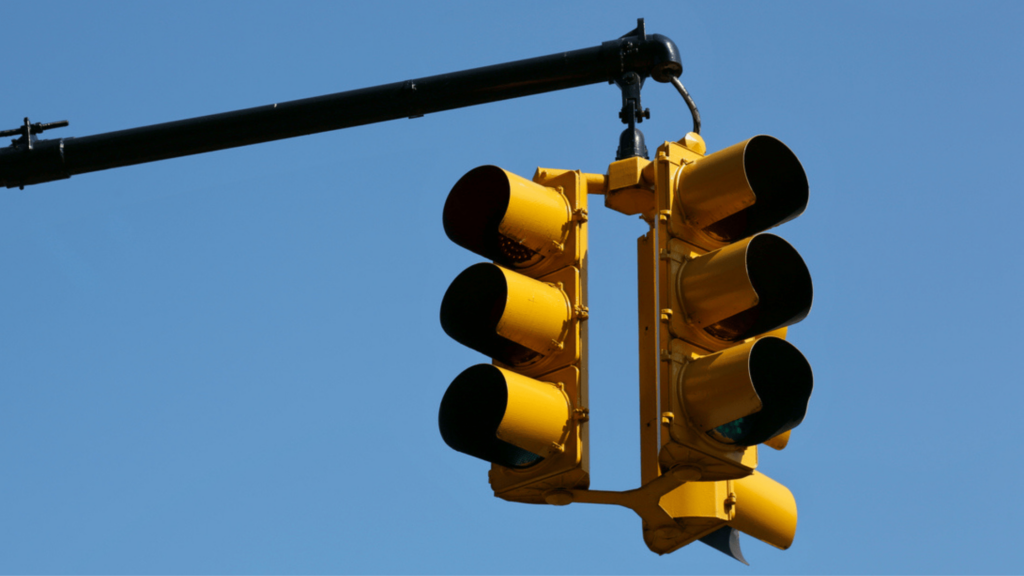- News
- When the Lights Go Out: Tips for Navigating Malfunctioning Michigan Traffic Lights.
When the Lights Go Out: Tips for Navigating Malfunctioning Michigan Traffic Lights.

With winter on the horizon, and the growing likelihood of weather-related power outages or other issues causing stoplights to fail, it’s probably a good time to remind everyone of a basic traffic rule: You’re required to come to a complete stop for red lights, and (unless you’re making a right turn at intersections where that is allowed) you are only permitted to proceed once the traffic signal turns green for your direction. It’s Driver’s Ed 101!
But what are drivers supposed to do when the power is out, or when traffic lights have stopped working for some other reason? Well, if you passed your driver’s education course and received your license to drive in Michigan prior to 2018, it might come as a surprise that there is now a legally required way to go through intersections with out-of-order stoplights. That’s right – a mere five years ago the state enacted legislation that instructs drivers how to proceed whenever they come across a traffic signal that’s not working. Read on to learn more.
If a Traffic Signal Is Out, Treat It Like a Four-Way Stop.
It’s a pretty simple solution – and one any experienced (or even inexperienced) driver ought to be able to handle with ease. When you come to an intersection where a traffic signal isn’t operational, you must come to a complete stop, look both ways, and proceed when cross traffic is clear. If there are other vehicles in the roadway going different directions, follow the normal rules for right-of-way to determine which car should go first. The same rule applies when there are multiple lanes, for instance where a cross street intersects with a multi-lane road like Woodward Avenue. You just have to pay closer attention to all the crossing traffic to stay safe in this kind of situation. We’ll spell out how the right-of-way is determined in a moment.
You may remember that we explained this in detail in a previous article which discussed how to properly merge onto highways… but four-way intersections have their own right-of-way rules to follow. Quoting from What Every Driver Must Know, the official driver’s education manual published by the Michigan Secretary of State Office, here’s what to do at intersections that are normally regulated by a four-way stop: “You must yield to other vehicles when you reach a four-way stop intersection with a stop sign at each corner of the intersection. The driver who arrived at the intersection and stopped first has the right of way through the intersection. If two or more vehicles reached the intersection at the same time, the vehicle on the left should yield to the vehicle on its right.” The manual goes on to further explain what should happen at intersections that have a non-working traffic signal and therefore are legally treated as a four-way stop: “You must yield to other vehicles when you reach an intersection with a malfunctioning traffic signal. Come to a complete stop and yield to vehicles already in the intersection. Yield to the vehicle on your right if you both reach the intersection at the same time.”
To be more specific, here are some additional particulars of state law governing right-of-way at malfunctioning traffic signals:
“The driver of a vehicle approaching an intersection that is controlled by a traffic control signal shall do all of the following, if the signal facing the driver exhibits no colored lights or colored lighted arrows, exhibits a combination of colored lights or colored lighted arrows that fails to clearly indicate the assignment of right of way, or the signals are otherwise malfunctioning:
a.) Stop at a clearly marked stop line, or, if there is no clearly marked stop line, stop before entering the crosswalk on the near side of the intersection, or, if there is no crosswalk, stop before entering the intersection.
b.) Yield the right of way to all vehicles in the intersection or approaching on an intersecting road, if those vehicles will constitute an immediate hazard during the time the driver is moving across or within the intersection.
c.) Exercise ordinary care while proceeding through the intersection.”
All of this sounds pretty simple, right? But it isn’t always easy to determine who got there first, and sometimes impatient drivers can take advantage of others by cheating – darting into the intersection without any warning or showing any concern for the safety of other drivers. There are also situations where drivers who have grown used to having the right of way through an intersection where the traffic signal is usually green for a long time in one direction will expect other drivers (especially those on less-traveled side streets) to simply yield to the flow of heavier traffic. That can lead to deadly crashes and even horrifying T-bone collisions. Be aware that if you or someone you love are killed or seriously injured (the state defines this as suffering “death, serious impairment of body function, or permanent serious disfigurement”) in a collision where another driver has ignored the state’s four-way stop requirement, you have the right to sue.
What if Local Authorities Fail to Repair a Broken Stoplight?
As we wrote in an article about pothole damage to cars this spring, it can be nearly impossible to successfully sue a municipality (or the Michigan Department of Transportation for that matter). This is due to the longstanding legal concept of governmental immunity. As a reminder, here’s some of what we discussed on the earlier article:
This form of legal protection for governmental entities dates back centuries to origins in English Common Law. It’s so firmly established, in fact, that you’ll be unlikely to win a case brought against any part of the government. In fact, MDOT’s website makes this somewhat chilling statement: “The majority of defect claims (regarding roads) are denied under governmental immunity laws.” Which is their way of saying that suing the government for damages is generally a waste of time and money.
We tend to agree, but that doesn’t mean it’s entirely impossible to sue the government and win significant compensation, as cases like the $626 million settlement in the Flint drinking water crisis demonstrate. So, before you decide to simply give up on pursuing legal action against the government, be sure to discuss your specific situation with a qualified Mike Morse Law Firm attorney. Even MDOT seems to agree with this suggestion, advising Michiganders that “if your alleged damage claim is $1,000 or more, you can recover only by filing a lawsuit against MDOT,” and stating that individuals should “consult a private attorney if you want to pursue this option.”
To help you win such a case, we’d definitely need to prove long-term negligence… meaning that if you and other citizens have reported a broken stoplight to authorities, and it isn’t repaired in a timely manner, they could be found negligent in their duty to safeguard public safety. Our advice in circumstances like this is to take numerous pictures showing the malfunctioning stoplight over a period (days or weeks), so you can prove the date you first reported the situation and demonstrate that it wasn’t addressed promptly after the authorities were notified. Be sure to keep records of when you first notified them of the issue, and also of any subsequent messages you’ve sent and any responses you might have received. It’s all about building a chain of evidence to support your claims. But hopefully you won’t have to take such dramatic steps. To help you out if you do encounter a malfunctioning traffic signal, here are links to a few municipalities that make it simple to report broken stop lights, potholes, and other highway hazards: Detroit, Grand Rapids, Kalamazoo, Bay City, Jackson, Ann Arbor, Wayne County, Macomb County, and Oakland County. The Michigan Department of Transportation also has an online contact form or you can call 517-241-2400.
If You’re Ever Hurt in an Accident That’s Not Your Fault, Let Us Help.
In circumstances like the ones we’ve described here – whether you’ve been injured due to the negligence of a municipality or an irresponsible driver who failed to observe four-way stops at malfunctioning traffic signals, your best friend will be a dedicated Mike Morse Law Firm attorney. We have the legal knowledge and the courtroom clout to get you the compensation you deserve. Call us at 855-MIKE-WINS (855-645-3946) and we’ll be at your side – and on your side – in no time!

Content checked by Mike Morse, personal injury attorney with Mike Morse Injury Law Firm. Mike Morse is the founder of Mike Morse Law Firm, the largest personal injury law firm in Michigan. Since being founded in 1995, Mike Morse Law Firm has grown to over 200 employees, served 40,000 clients, and collected more than $1.5 billion for victims of auto, truck and motorcycle accidents. The main office is in Southfield, MI but you can also find us in Detroit, Sterling Heights and many other locations.








